How to Build a Charcuterie Board

Last updated September 7, 2023
Charcuterie boards have long been popular party centerpieces. Versatile and for any size gathering, charcuterie boards give guests a snacking option prior to the main event at a dinner party. From savory to sweet spreads, this guide will teach you tips and tricks that will make building an outstanding charcuterie board a breeze.
Table of Contents
Get Started
Crackers & Cheese
Meat
Sweets & Briny Additions
Nuts & Crudités
Finishing Touches
Get Started
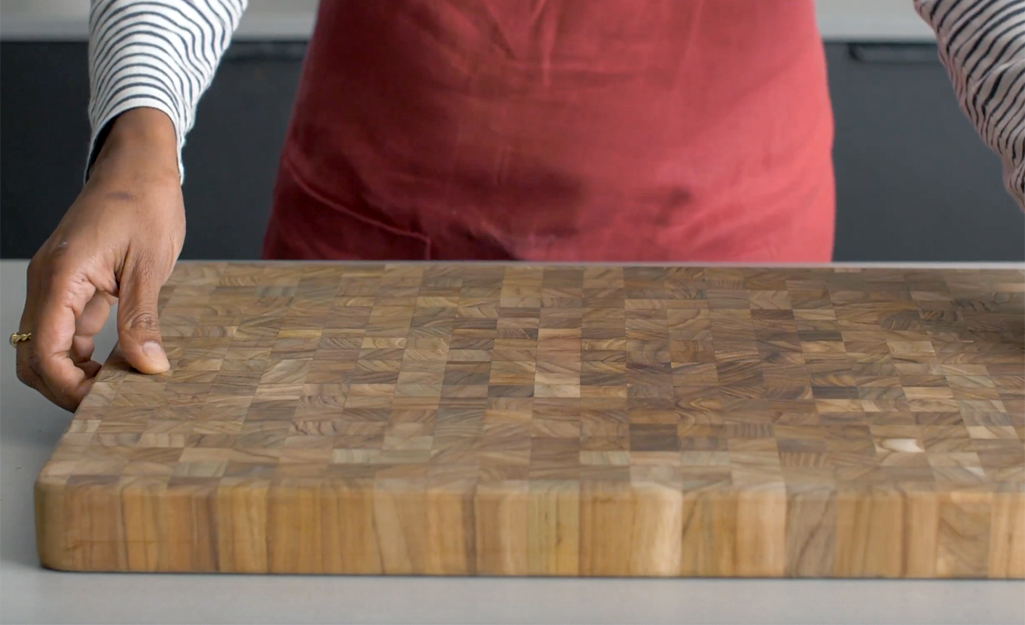
Charcuterie boards are party no-brainers because of how eye-catching they are. They serve not only as a source of snacks, but also as an impressive visual display for any gathering. Beyond the visual aspect, charcuterie boards are a great way to ensure guests have a diverse spread of textures and flavors to choose from. With a charcuterie board, guests are invited to a choose-your-own-adventure experience, in which they can select the components that excite them most.
The first step to building a charcuterie board is understanding who you’re aiming to feed and how full you want them to be. Rather than fretting over folks getting too full prior to dinner, you can opt to have your charcuterie board be the main event. If you plan accordingly, guests will be satisfied by the meat, cheese and accompanying accoutrements. Follow these rules of thumb to make sure guests aren’t left wanting:
- If your goal is to offer a light snack prior to a dinner, ensure you have 2 oz. of cheese per person and 1 to 2 oz. meat per person on your board.
- If your charcuterie board is all you’ll be serving and you want to make sure no one is left hungry, plan for 4 oz. of cheese per person and 3 to 4 oz. meat per person.
Consider budget. Building a charcuterie board does not have to be an expensive undertaking. If you’re hoping to keep the costs down without scrimping on quality or wow factor, follow these tips:
- Shop from your refrigerator. Given that a charcuterie board’s key trait is diversity, you should be able to start building by using whatever you already have in the house. Use up leftover cheeses, crackers and more, then supplement with a shopping trip.
- Do your shopping at the grocery store rather than a deli or specialty good store.
- Unless you have a very specific craving, shop sales.
- Check your grocer’s cheese ends-and-pieces basket. This is where you’ll find odd pieces of artisanal cheeses that the grocer is looking to sell at a discount.
- Cured meats can get pricey. Your least expensive options are pepperoni and salami.
- Your investment in cheese will go furthest if you choose whole blocks of cheese rather than anything pre-sliced and individually packaged. Parmesan and cheddar are crowd favorites on the affordable side.
- Don’t get too over-the-top with your cracker selection. Classics do the trick.
- Fruits and vegetables that are in season will be more affordable than those that are not, so shop seasonally. For fruit, apples and grapes are inexpensive options year-round.
Once you have all of the non-food items your board needs, you can move on to the fun, super customizable part: selecting the meats, cheeses, crackers, briny and sweet bits that will make your board perfection.
Crackers & Cheese
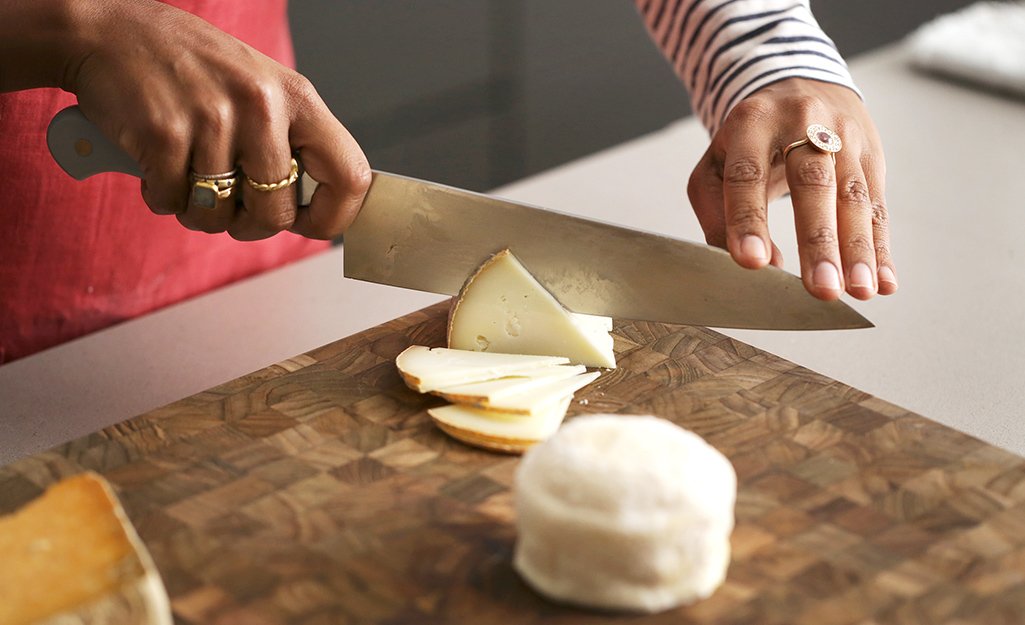
Crackers:
- While some people favor bread (sliced baguette, grainy rustic loaves), a classic charcuterie board will include crackers. The reason behind this is that they offer a snap and textural contrast that a softer bread does not. Crackers are also more bite-sized than most bread options, making them an easier option for noshing at a gathering.
- Your best bet is to have at least two cracker options. One should be neutral, such as a classic water cracker. This is the choice for someone who wants a crunch to accompany their meat, cheese or a spread, but doesn’t want an added flavor component. The second should have more depth of flavor, think of something with some seeds or nuts within, or that uses a dark, wholesome tasting grain. Alternatively, your flavor-packing option could be a buttery, thick cracker that melts in the mouth. If you’re serving a crowd, you can offer both.
Cheese:
- Often the central focus, cheese is an integral part of the charcuterie board. Selecting cheeses is all about balance. With the right combination, you will offer an exciting array of textures, flavors and even appearances. Since a charcuterie board is such a visual offering, you should also be mindful of the shapes and colors of the cheeses you select.
- The best way to ensure you have the right cheese lineup is to think about a few factors: the type of milk used to create the cheese, its intensity of flavor and the hardness of the cheese.
For most occasions, you will want three to four cheeses. - Texturally, this means you should have one soft and spreadable cheese, like brie, one medium firm, like gouda, and one extra hard, like manchego. The fourth cheese is your wildcard.
- Types of milk also break into three categories. Aim to represent cow, goat and sheep’s milk.
- Flavor is more subjective, but verify that you have cheeses to suit everyone’s tastes. Stick to just one blue cheese, for example.
- An advanced way to approach variety is to think about age. You can opt for a fresh goat or ricotta, something that has been lightly aged (this will be true of any mild hard cheese) and something that’s been aged for quite some time (look for something that’s a little bit funky).
- To prepare the cheeses, let them get to room temperate before serving. Make sure they’re well spread out across the board, ideally with a knife for each sort – this is especially important if you’re serving super flavorful cheeses. Any soft cheeses should get a spreader rather than a standard knife. Cut into the cheeses, making pretty crumbles on the board or letting a bit of a soft cheese ooze out. It can be intimidating for a guest to take the first bite, so this will make the spread more inviting.
Meat
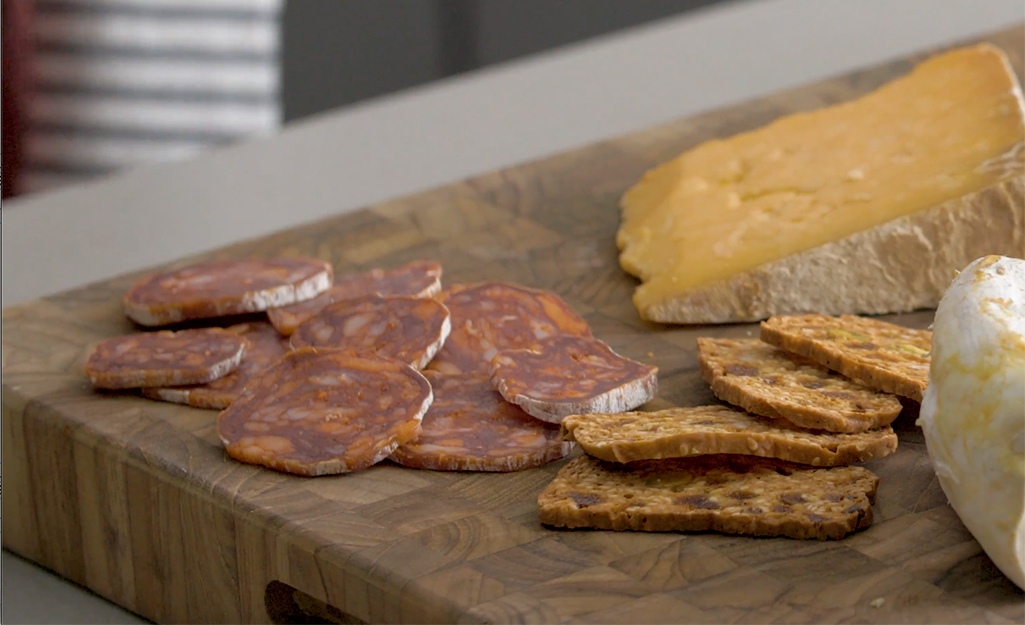
As is the case with cheese, you want the meat on your charcuterie board to represent a well-balanced variety of textures, flavors and animal sources. When it comes to cured or dried meats, pork is quite common, but you can also find beef and chicken options at your deli.
Make sure to include at least one hard “encased meat,” like a salami, and one that’s a bit softer, or a “whole-muscle cut,” like prosciutto. Consider flavor balance when selecting meats. Try to have two to three meats with varying spiciness and fat levels, so everyone can enjoy.
If you are serving a mixture of vegetarians and meat-eaters, make sure the meats are assigned to one side of the board, if not given their own serving platter. Fold whole-muscle cut meats to look attractive and accompany encased meat with a knife, cutting a few pieces to get the ball rolling.
Sweets & Briny Additions
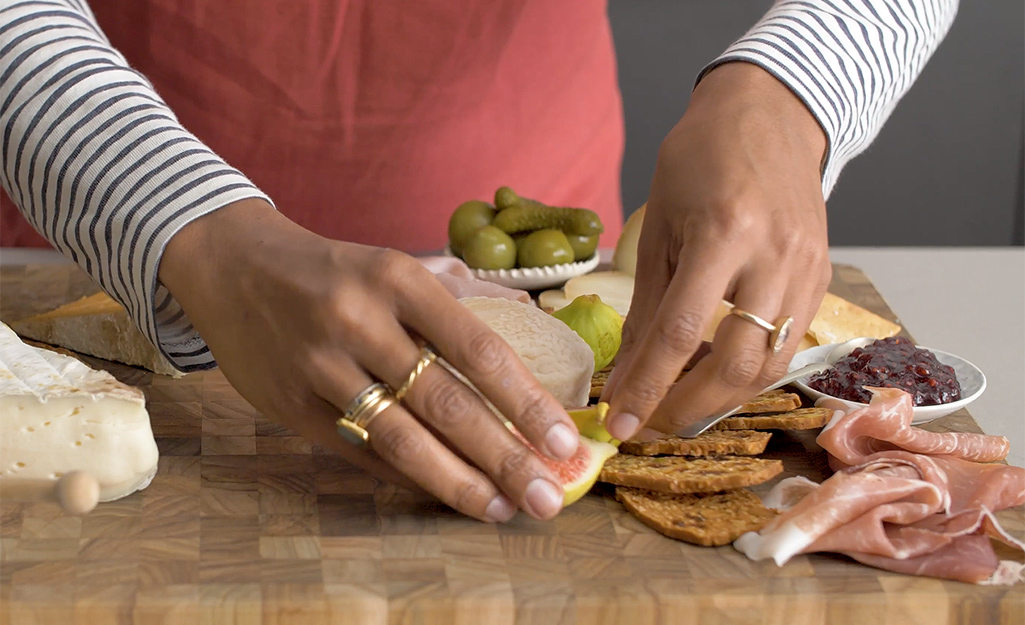
Sweets: Opposites often attract. This is true of fatty, savory foods like cheese and meat, and sweet things like fruit, dried or fresh, and jams. Again, season and color should be your guide. Figs, apricots, raspberries, grapes and apples all work. Just make sure they look nice next to whatever you’re serving and are easy to find during the season.
You can scatter small whole fruit or slices of larger fruit around the board, or can opt for jam in a small serving bowl. Whole fruit makes for a great bite, and jams will add to a layered stack of meat, cheese and cracker.
Briny Additions: No charcuterie board is complete without a briny element. Olives and pickles of any sort (classics or pickled vegetables like radishes, green beans or more) pair wonderfully with rich cheese and meat.
Nuts & Crudités
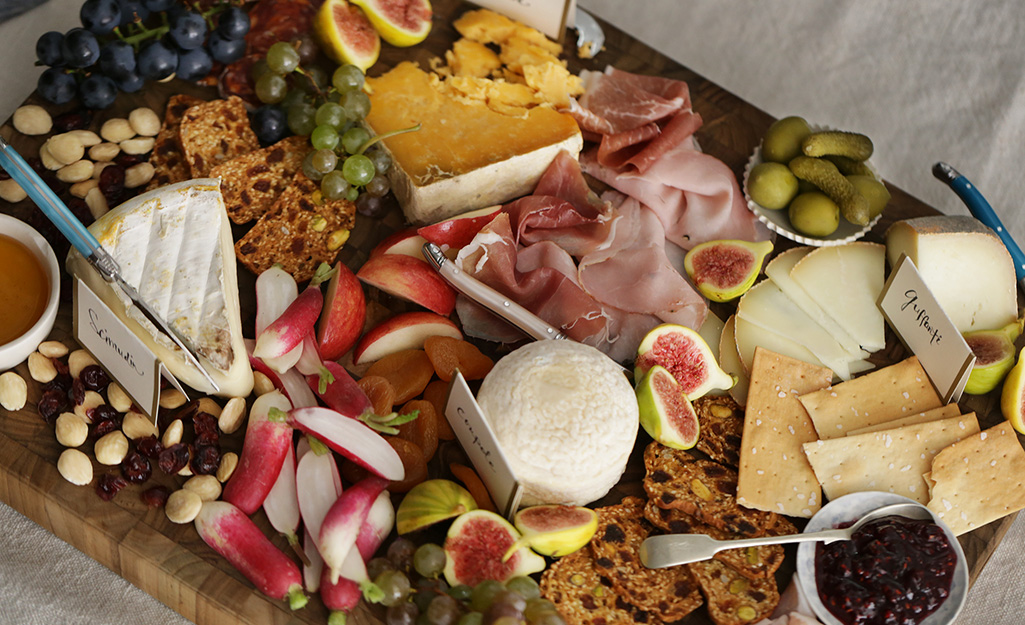
Nuts: Give your guests a bit of crunch by including some nuts on your charcuterie board. Anything from cashews to walnuts to marcona almonds will do. Nuts are also great tools for filling holes on your charcuterie board. Scatter them around as a finishing touch or serve them in a bowl that can sit right on the board.
Crudités:
- Since balance is the key to building an exceptional charcuterie board, it is important to offer crisp, bright bites that will give guests a palette cleansing crunch and also an element of healthfulness. This is why vegetable spears or slices are an important component. Vegetables also add a pop of color to the board.
- When selecting your vegetables, think about color. What will look best on the board? Orange? Go for carrots. Something green? Blanched broccoli or green beans are great. You should also keep season in mind. To serve your guests the best possible vegetable bites, make sure that they are growing plentifully at that time of year.
- Make sure you’ve cut the vegetable into approachable pieces. If you decide to heavy up on the greenery, include a dip to accompany, like hummus, a yogurt-based dip or something zippy like a chimichurri.
Finishing Touches
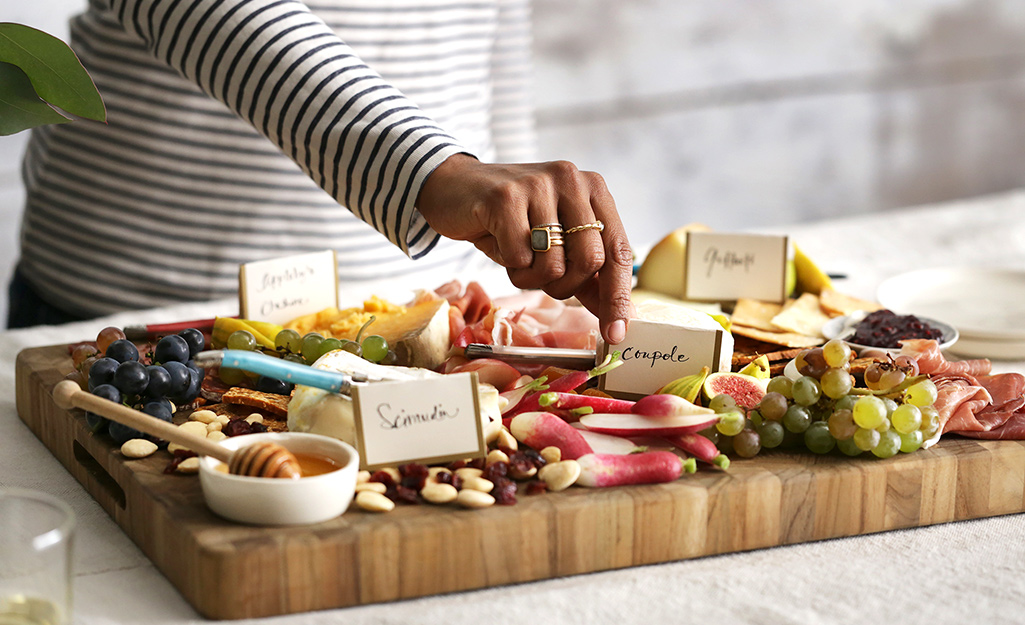
Once you’ve gathered all of the odds and ends for your charcuterie board, turn your attention to assembly. Start with the largest items to make sure you have enough space. Cheese can go first, then bowls of jam or small items can get placed down to give you a sense of the space they’ll need. Follow by laying down your meats, then the color and texture flourishes like olives, vegetables, fruits and nuts. You can even include edible flowers if you’d like. Fill every nook and cranny to create a look of bounty.
If you’re looking to go the extra mile, you can include labels for each of your meats and cheeses. Guests will love knowing exactly what they’re enjoying.
From savory to sweet spreads, building a charcuterie board is quick and easy with right kitchen tools and ingredients at hand. Looking for ways to prep and serve an enticing charcuterie spread? The Home Depot delivers online orders when and where you need them.

































